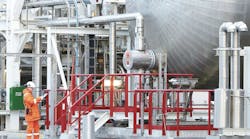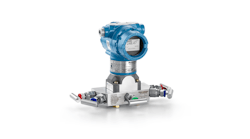BOYLE’S LAW: An ideal gas law that states that the pressure of a fixed mass of gas at a constant temperature is inversely proportional to the volume of the gas. Stated another way: the product of the pressure and volume of an ideal gas will always be equal as long as the mass and temperature are constant.
CAPACITIVE GAUGE: A type of sensor that measures pressure based on a change in capacitance. Molecules strike a diaphragm inside the sensor and cause its shape to change. The shape change causes the distance between the diaphragm and a second reference plate to change, which is measured as a change in capacitance between the two plates that is proportional to pressure.
DIAPHRAGM: A sheet of semi-flexible material commonly used in a capacitive gauge to measure pressure. The material and the dimensions of the diaphragm are controlled to allow repeatable measurement between instruments, and each gauge is commonly calibrated for accuracy.
MANOMETER: A pressure sensor that compares the pressure where a measurement is desired to a reference pressure. The reference pressure for a pressure gauge is commonly atmospheric pressure, while a vacuum capacitance manometer commonly uses a hard vacuum for the reference pressure.
PRESSURE: A measure of force per unit area that a medium exerts on a surface. The measured force is the result of the molecules in the liquid or gas striking the surface in question.
PRESSURE CONTROLLER: An automated instrument made up of a pressure sensor, a control valve, and a PID controller that maintains desired gas pressure(s) in a system. After receiving the desired pressure electronically, the pressure controller adjusts the control valve position to let the flowrate necessary to maintain the desired pressure pass through the instrument.
PRESSURE GAUGE: An instrument that provides a display of pressure in the system. These can be configured to provide indication only, some can include an electrical pressure alarm, and others can provide an electrical output of the pressure reading.
PLASMA SHIELD: A component in some vacuum capacitance manometers that protect the diaphragm from process byproduct deposits. Process byproducts that deposit onto the diaphragm reduce the accuracy of the measurement and reduce the lifetime of the manometer in the process.
REGULATOR: An instrument used to maintain a fixed level of pressure to a process. These are often paired with pressure gauges, and are commonly used to maintain a desired pressure out of a gas tank that’s being fed into a process.
REMOTE SENSOR: A pressure control configuration where the pressure sensor is mounted remotely in relation to the pressure control device. Some vessel pressure control applications mount the pressure sensor on the vessel itself, and the actual control is performed by a pressure controller on a pipe varying gas flow into the vessel, or sometimes by a throttle valve varying gas flow leaving the vessel.
STRAIN GAUGE: A type of sensor that measures pressure based on a change in resistance. Molecules strike a strain gauge of a fixed resistance inside the sensor and cause its shape to change. The shape change causes the resistance of the strain gauge to change, which is measured and is proportional to pressure.
TRANSDUCER: An instrument that changes energy from one form to another. A pressure transducer commonly changes the mechanical energy imparted on a strain gauge into an electrical output that represents pressure.
VACUUM: A measure of pressure below atmospheric pressure and above an absolute pressure of zero. Pressures in this range are commonly expressed in absolute units.
VESSEL: A closed volume where a desired reaction occurs that typically benefits from pressure control to maximize output. This can be a chemical/biochemical reaction that occurs within a narrow positive pressure range, or a vacuum application that occurs at certain vacuum levels with certain gases present.
THROTTLE VALVE: A valve that provides a variable restriction to gas flow by incrementally rotating between an open and closed position. These are commonly used between a vacuum chamber and a vacuum pump to control the amount of gas leaving the chamber to maintain a desired pressure.
The terms and definitions for this word search were provided by Brooks Instrument, www.BrooksInstrument.com, a manufacturer of flow, pressure and level technology.

